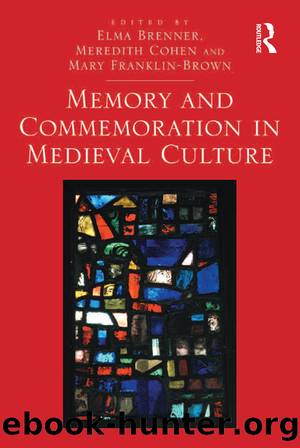Memory and Commemoration in Medieval Culture by Cohen Meredith. Franklin-Brown Mary. Brenner Elma. & Meredith Cohen & Mary Franklin-Brown

Author:Cohen, Meredith.,Franklin-Brown, Mary.,Brenner, Elma. & Meredith Cohen & Mary Franklin-Brown
Language: eng
Format: epub
Publisher: Taylor & Francis (CAM)
Published: 2013-01-15T00:00:00+00:00
1 The manuscript discussed in this chapter, Biblioteka Kórnicka 824 (hereafter âBK 824â), was the subject of my PhD dissertation, âFonctions et usages des images dans les manuscrits juridiques. Le Digestum Vetus de Justinien de la Bibliothèque de Kórnik, BK 824â (CESCM, Poitiers/ Warsaw University, 2007).
2 Frances A. Yates, The Art of Memory (London, 1966); Mary Carruthers, The Book of Memory: A Study of Memory in Medieval Culture (Cambridge, 1990); Mary Carruthers, The Craft of Thought: Meditation, Rhetoric, and the Making of Images, 400â1200 (Cambridge, 1998).
3 See Sylvia Huot, âVisualisation and Memory: The Illustration of Troubadour Lyric in a Thirteenth-Century Manuscriptâ, Gesta, 31 (1992): pp. 11â12 and Susan Lewis, Reading Images: Narrative Discourse and Reception in the Thirteenth-century Illuminated Apocalypse (Cambridge, 1995), pp. 250â53; for a more nuanced opinion, see Lucy Freeman Sandler, âThe Study of Marginal Imagery: Past, Present, and Futureâ, Studies in Iconography, 18 (1997): pp. 40â43.
4 In the Middle Ages the 50-book Digest was separated into three volumes: vetus, infortiatum and novum.
5 The Kórnik Digest follows the standards in production of legal manuscripts, noticeable already around the mid-twelfth century: a double-column format and text divisions consisting of rubricated books (libri), titles (tituli) and laws (leges) with inscriptiones beginning with an initial in red or blue. It is also distinctive for its inclusion of several pre-accursian glosses, both interlinear and marginal. Gero Dolezalek roughly dated the manuscript to the end of the twelfth century in his Verziechnis der Handschriften zum römischen Recht bis 1600 (4 vols, Frankfurt, 1972), vol. 1 (Kórnik), a dating with which I concur. For further discussion of the dating of the manuscript, see my âFonctions et usagesâ, pp. 34â52.
6 The main artist, Master A, can be identified with the Master of the Albenga Psalter (see Anna de Floriani, Miniature parigine del Duecento: il Salterio di Albenga e altri manoscritti (Genoa, 1990)). Master B, who worked with an apprentice, is perhaps the illuminator of the Lewis Psalter (Philadelphia, Free Library), ms. E 185. The work of Master C, the only non-Parisian contributor, seems similar to that of the English artist of the Huntingfield Psalter (New York, Pierpont Morgan Library), M. 43. For a more detailed analysis, see my âSupplément ou commentaire? Les enjeux de lâillustration textuelle dans le Digestum vetus de Justinien (Bibliothèque de Kórnik, ms. 824)â, Biuletyn Historii Sztuki, 70 (2008): pp. 63â89.
7 The instructions are still visible in some bas-de-pages. They are transcribed in my âPomiÄdzy tekstem i obrazem. Dyrektywy dla miniaturzystów w Digestach Justynianaâ, Ikonotheka (2005): pp. 1â21 (with a summary in French).
8 The first version of the glossa ordinaria was ready in the 1220s, but Accursius (c. 1182â1263) never ceased amending and adding to his commentary. See Frank Sotermeer, Utrumque ius in peciis. Aspetti della produzione libraria a Bologna fra due e trecento (Milan, 1997), p. 45.
9 These marginal drawings have been the subject of some occasional references: see Susan LâEngle and Robert Gibbs, Illuminating the Law: Legal Manuscripts in Cambridge Collections (London, 2001), pp. 105â10 (Cat. No. 1) and Barbara
Download
This site does not store any files on its server. We only index and link to content provided by other sites. Please contact the content providers to delete copyright contents if any and email us, we'll remove relevant links or contents immediately.
Technical Art History by Jehane Ragai(234)
The Slavic Myths by Noah Charney(199)
Drawing Landscapes by Barrington Barber(181)
Simply Artificial Intelligence by Dorling Kindersley(170)
Compacts and Cosmetics by Madeleine Marsh(168)
Drawing for the Soul by Zoë Ingram(161)
The Art of Painting Sea Life in Watercolor by Maury Aaseng Hailey E. Herrera Louise De Masi and Ronald Pratt(153)
The Art of Portrait Drawing by Cuong i(150)
Preparing Dinosaurs by Wylie Caitlin Donahue;(142)
Egyptian art by Jean Capart(139)
A text-book of the history of painting by Van Dyke John Charles 1856-1932(132)
Pollak's Arm by Hans von Trotha(127)
Winslow Homer by Shibutani Baku(125)
Botanical Illustration by Valerie Price(112)
Through Japan with Brush & Ink by Chiura Obata(112)
Culture and Ideology under the Seleukids by Eva Anagnostou-Laoutides Stefan Pfeiffer(111)
Pornoterrorism: De-Aestheticising Power by Louis Armand Jaromir Lelek(108)
The Fashionable Mind by Kennedy Fraser(105)
Jane Evans. Chinese Brush Painting. A Complete Course in Traditional and Modern Techniques by Unknown(100)
